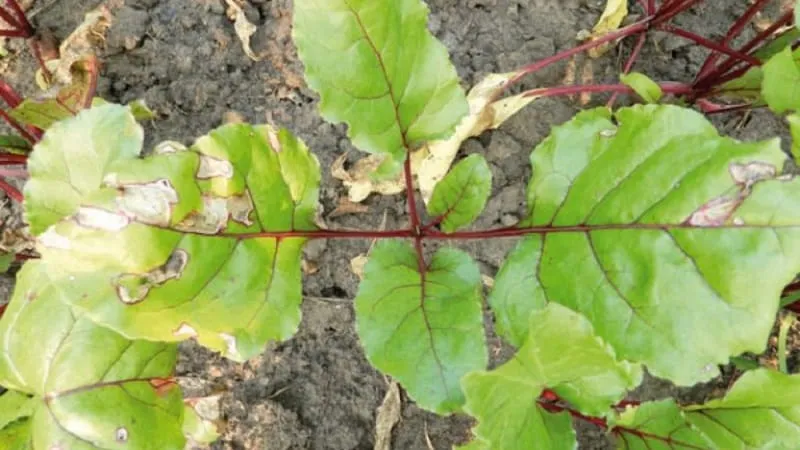Mistakes in the care and cultivation of root crops are primarily reflected in the plant's foliage. The leaves turn yellow, dry out, become spotted, and die off. Beets are no exception.
Yellowing beet leaves are a sign of disease or improper plant care. In this article, we will explain what to do when beet leaves turn yellow and the plant stops growing.
Table of contents
Main Causes of Leaf Discoloration
The condition of the foliage is an indicator of proper root crop development. A healthy vegetable has rich, bright green leaves. Why do beet leaves in the garden turn yellow? It is natural to observe the drying and dying of lower beet leaves in August, when the vegetable is almost ripe and ready for harvest.
However, if the lower leaves turn yellow in July, it means the beets need help.
Main reasons for yellowing and drying of beet foliage:
- insufficient watering;
- lack of nutrients in the soil;
- pest infestations;
- disease infections.
Lack of moisture and nutrients, particularly nitrogen, are the primary causes of problems with beet foliage. However, other negative factors also deserve separate consideration.
Lack of Moisture in the Soil
Beets are not a moisture-loving crop. However, root crops need regular soil hydration for growth and development. The frequency of watering beet beds depends on weather conditions and the plant's growth phase.
The watering schedule should be followed from the moment of sowing. Beets are sown in well-moistened soil. Until mass germination, ensure the soil remains consistently moist. Since young sprouts are still weak and the root system is undeveloped, deep watering is unnecessary.
Important! Beets require the most water during the initial formation of root crops.
During the formation and intensive development of the root crop, water generously — up to 20 liters per square meter. Stop watering 2-3 weeks before harvest.
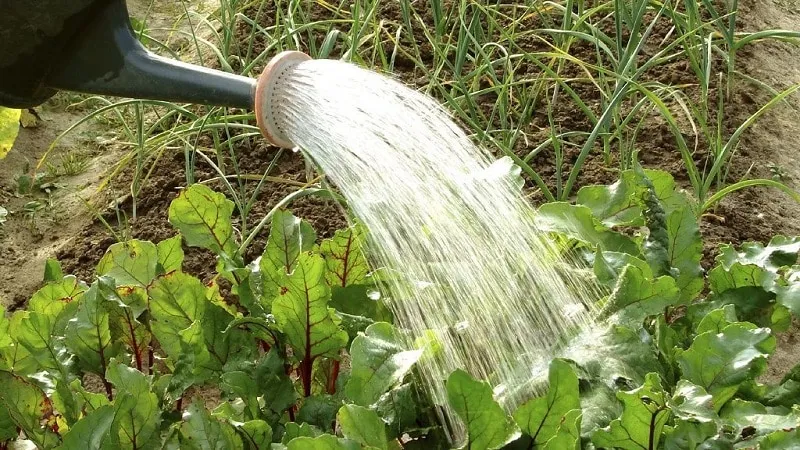
In hot, dry summers, water abundantly and regularly, about once a week. Light daily irrigation is a mistake. This only moistens the topsoil, while the root crop receives little water. If the summer is not warm, watering at a rate of 10 liters per square meter is sufficient.
Tip. Avoid watering during the day, as wet foliage can get sunburned.
It is important not to overdo it. Excess moisture is just as harmful as its lack. Overwatering reduces oxygen levels in the soil, causes root rot, and promotes the growth of pathogenic microbes.
Nutrient and Micronutrient Deficiencies
Another common cause of yellowing leaves is a lack of nutrients in the soil.
Beet foliage reacts differently to the deficiency of specific elements: it may turn yellow, red, or become spotted.
Yellowing leaves indicate a nitrogen deficiency. This element is crucial for the development of root crop foliage.
Under nitrogen starvation, leaves grow small and limp before changing color. The veins thicken and harden first, followed by the entire leaf.
Reddening leaves signal a magnesium deficiency. Spots and dying leaf tips indicate an iron deficiency.
Additionally, the crop is sensitive to insufficient boron and manganese levels in the soil. This problem is typical for sandy and limestone soils.
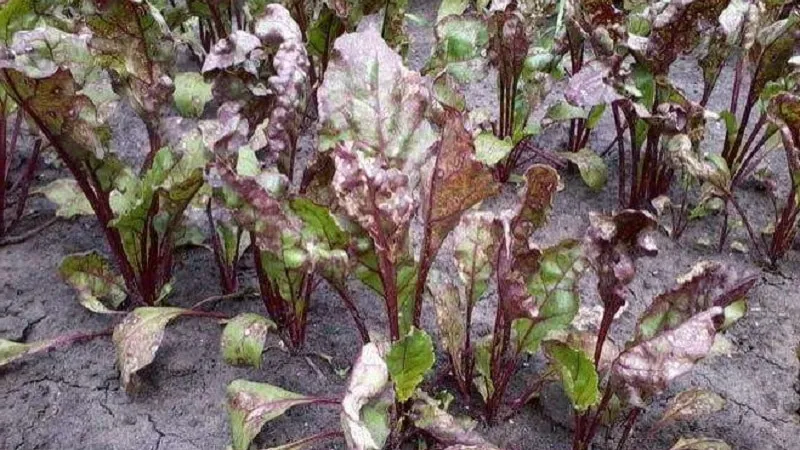
Disease Infections
Yellow-green discoloration of foliage often indicates disease development. Such symptoms are characteristic of downy mildew, brown rot, cercospora leaf spot, blackleg, rust, and beet yellows.
Downy Mildew
Downy mildew — a fungus transmitted through infected plant debris, wind, and water. Infection is identified by leaf deformation, gray-purple coating, yellowing, and wilting.
Brown Rot
Brown rot — a disease affecting the root crop itself. Symptoms include stunted foliage, yellowing, die-off, and rotting of beets during winter storage.
Rust
The disease manifests as round orange spots on leaves, which later appear on petioles and stems. Photosynthesis is disrupted in infected plants, leading to yellowing and die-off.
Blackleg or Damping-Off
Damping-off — a root system disease caused by a complex of soil fungi and bacteria. Symptoms include yellow, wilted leaves. Excess moisture triggers infection.
Cercospora Leaf Spot
Cercospora leaf spot — a fungus causing light spots with brown edges. Over time, leaves dry out, turn black, and wither.
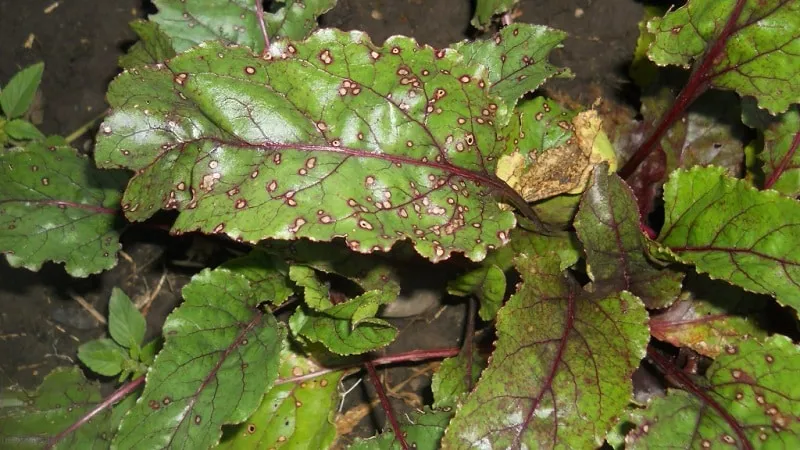
Beet Yellows
The disease is characterized by yellowing of lower and middle leaves, starting at the tips and spreading along the edges and between veins. Aphids transmit the disease, and weeds can also be a source of infection.
Pest Infestations
Pest invasions are another reason beet foliage changes color and falls off.
Pests pose the greatest threat to young, unestablished plants. Few insects can damage beet crops. Below are details on each.
Beet Aphid
A wingless black insect with a greenish or brown tint. Larvae are light or dark green. Aphids lay shiny black eggs.
The pest thrives where euonymus, viburnum, and jasmine grow. In autumn, aphids lay eggs on these shrubs. In spring, larvae emerge. When shrub leaves toughen, aphids migrate to beet beds, where they reproduce until autumn. With cold weather, they return to shrubs to lay eggs.
The pest sucks plant sap, causing leaves to dry, deform, and curl. Growth slows, and root crops become small and misshapen.
Common Beet Flea Beetle
A small bronze-metallic beetle with spotted wings. The pest overwinters in sheltered areas (e.g., windbreaks) and becomes active in April-May. It feeds on young beet shoots and weeds, laying eggs in late spring. Larvae consume plant roots.
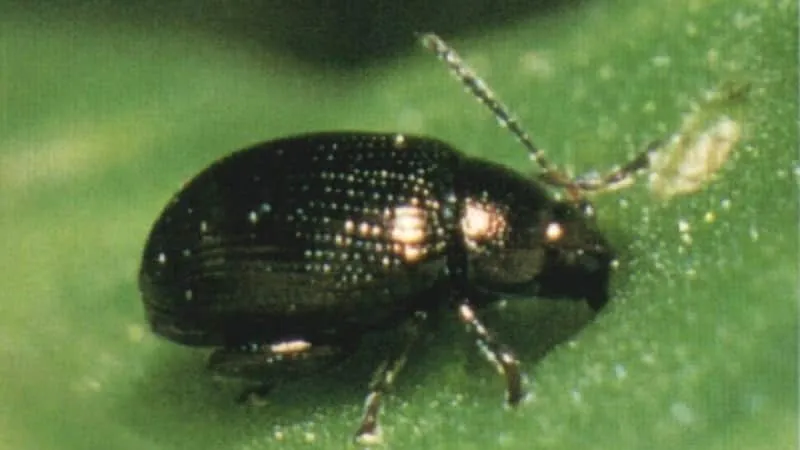
Infestation is identified by small holes in leaves and petioles. Heavy infestations turn leaves lace-like.
Beet Tortoise Beetle
A flat green or brown beetle, 6-7 mm long. It overwinters under plant debris and weeds, emerging in April-May. Females lay eggs on beet leaves, and larvae hatch to feed on foliage, creating holes.
Larvae cause the most damage, consuming entire leaves except veins.
Beet Leaf Miner
A gray-brown fly, 6-7 mm long. Larvae are pale yellow, 6-8 mm, with wrinkled bodies.
Eggs are laid on the underside of beet leaves. Larvae burrow inside, creating cavities (mines). Damaged areas appear as blisters. Affected foliage yellows and dries. Early growth stage damage is particularly harmful.
Beet Weevil
A gray-brown beetle, 12-16 mm long. It can devastate large beet fields. Adults emerge in late April–early May when soil warms to +10°C.
Initially, they feed on weeds like goosefoot and amaranth before moving to beet seedlings. Young plants are vulnerable — chewing cotyledons halts growth.
Weevils lay eggs in soil. Larvae emerge in 11 days and gnaw beet roots, causing misshapen root crops.
How to Combat Yellowing Foliage
How to address this? First, identify the problem source.
Lack of moisture is corrected with regular, ample watering. Beet watering rate is about 15 liters per square meter. Avoid water stagnation — reduce amounts if necessary.
When root crops begin to bulk up, reduce watering frequency. In cool, rainy weather, water less. Decrease water amounts in August. Stop watering 2-3 weeks before harvest.
Nutrient deficiencies are addressed with root and foliar feeding. A quick fix is manure or poultry manure solution (1 kg per bucket of water). Apply between rows (1 bucket per 10-15 linear meters). Rinse off any fertilizer on leaves. Liquid feeding is done in July, when nutrient demand peaks.
For disease-related issues, treat plants. Brown rot is treated with boron. For black rot, reduce soil moisture and aerate. Lime acidic soils.
To prevent cercospora leaf spot, treat seeds with heat. If disease appears, dust leaves with chalk and apply boron solution.
For rust, spray crops with fungicides. Avoid excessive nitrogen fertilization and grow resistant varieties.
For pest control, use insecticides, tobacco infusion, or soap solution. Wormwood decoction is also effective.
Note! Spray as soon as pests are detected, before leaves curl.
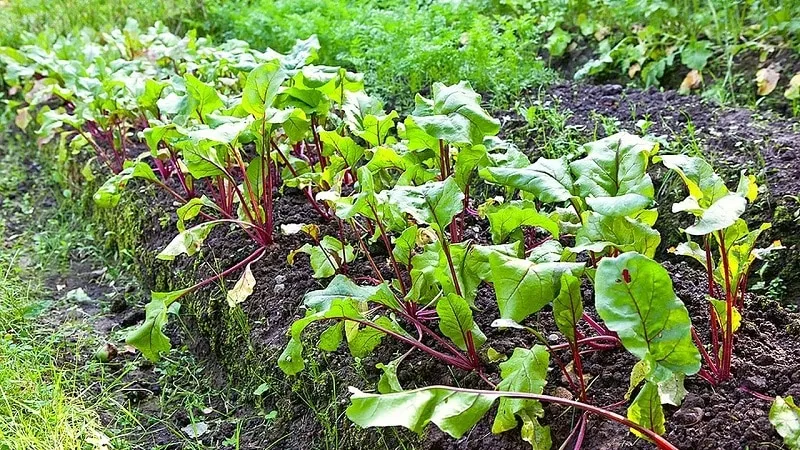
Preventive Measures
To avoid beet cultivation issues, prepare in advance. Preventing yellowing and drying includes ensuring proper nutrition, adhering to watering schedules, weeding, and crop rotation.
Yellowing foliage is often caused by nutrient deficiencies. Regular fertilization is crucial. Mid- and late-season varieties are fed at least twice: after first leaves appear and again three weeks later.
Important! Follow fertilizer dosages. Remember, root crops accumulate nitrates.
To prevent pest infestations, thoroughly cultivate beds and remove weeds. Leaves damaged by leaf miners are cut and discarded. In autumn, till soil and clear plant debris to eliminate pest overwintering sites.
A simple pest control method is attracting predatory insects. Ladybugs and lacewings prey on aphids. Plant calendula, cornflower, dill, geranium, or tansy to attract them.
Note. Insecticides kill both pests (which rebound quickly) and beneficial insects.
Disease prevention includes seed disinfection, autumn field cleanup, weed removal, and soil aeration. Choose disease- and pest-resistant varieties.
At harvest, protect root crops from damage and frost. Sort stored beets carefully to prevent disease spread.
Conclusion
Emerald green beet foliage indicates healthy root crops. Proper fertilization, watering, disease, and pest control prevent yellowing and drying of beet leaves.
